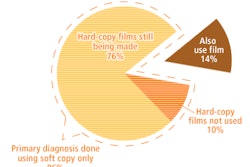News of adverse events related to medical imaging procedures have dominated the headlines in recent months, with stories ranging from radiation overdoses to contrast reactions. It's enough to make a patient think twice before entering the imaging suite, particularly in the outpatient imaging environment, which doesn't have access to the same level of emergency care as hospitals do.
But while adverse events sometimes do occur, the rate of events in outpatient imaging is actually quite low and the outpatient radiology setting is generally safe, according to a new study in the Journal of the American College of Radiology.
In the article, Dr. Lisa Shah-Patel, of St. Luke's-Roosevelt Hospital Center in New York City, and colleagues examined adverse event logs from a freestanding outpatient imaging center in a large urban area from January 2003 to December 2006. Their research was published in the April 2009 issue of JACR (Vol. 6:4, pp. 263-267).
"Often the emotions one feels if something goes wrong in a hospital are very different from those in an outpatient setting, because patients tend to equate hospitals with safety," Shah-Patel wrote.
Adverse events can include mild reactions such as hives and itching; moderate reactions, such as nausea, vomiting, dizziness, headache, falls or fainting, and nasal congestion; and severe reactions, such as shortness of breath, chest pain, or anaphylaxis.
Imaging exams performed in the outpatient center studied during the time frame included PET/CT, CT, and MRI, as well as interventional procedures, ultrasound, mammography, and breast biopsy. Adverse event logs were completed by the radiologist, physician assistant, nurse, or technologist.
Adverse events were defined as any sign or symptom a patient experienced while in the office, before, during, or after an imaging study or interventional procedure. Those patients who underwent contrast-enhanced CT received iopromide (Ultravist 300, 300 mg/mL, Bayer HealthCare Pharmaceuticals, Wayne, NJ); those who had gadolinium-enhanced MRI received gadopentetate dimeglumine (Magnevist, Bayer).
Fifty-nine adverse events were reported from 106,800 exams performed during the time frame studied, affecting 20 men and 39 women. Seventy-six percent of the patients were treated in the office, and 31% of the patients required emergency medical assistance.
Number of studies performed in each imaging modality and number of adverse events for each modality from January 2003 to December 2006
|
|||||||||||||||||||||
| *Mammography included ultrasound-guided breast biopsy and needle localization. Both tables courtesy of JACR. |
Adverse events by imaging modality and interventional procedures
|
Ionic iodinated contrast material seems to increase the possibility of allergic reactions, according to the authors. In one 2001 study that collected data for four years after patients had received intravenous contrast agents, more than 90% of the adverse events found were allergiclike reactions; there was an adverse reaction rate of 6% to 8% when ionic iodinated contrast material was used. This rate decreased to 0.2% when nonionic agents were used universally.
Overall, the study demonstrated that in a freestanding outpatient radiology office that serves more than 25,000 patients yearly, there was an adverse event rate of only 0.06% during the four-year time span reviewed.
The researchers didn't compare their findings to adverse event rates in hospitals, because the goal of the study was to establish a baseline rate of adverse events in outpatient imaging. But other studies have reported that hospital rates range from about 2.9% to 3.7%, according to a 2008 report from the Department of Health and Human Services' Office of Inspector General titled "Adverse Events In Hospitals: Overview of Key Issues."
Despite the low rate of adverse events, outpatient centers should always be well equipped with medical supplies and devices, such as sharp disposal containers and standard first-aid supplies. Physicians and physician assistants should be trained in basic and advanced cardiac life support, according to Dr. James Silberzweig, one of the study's co-authors.
"Although the overall risk of a reaction to contrast is quite low, adverse events do occur and can be quite significant," Silberzweig said. "It makes a difference for outpatient staff to be supported and prepared."
By Kate Madden Yee
AuntMinnie.com staff writer
May 4, 2009
Related Reading
Outpatient imaging: Key trends in a tumultuous healthcare environment, March 30, 2009
Imaging and the economic crisis: Part 2 -- Recovery and reform, March 24, 2009
Imaging and the economic crisis: Part 1 -- Sudden impact, March 19, 2009
Report: Hospitals hit by capital crunch, February 2, 2009
Survey forecasts drop in capital purchasing, December 18, 2008
Copyright © 2009 AuntMinnie.com




















